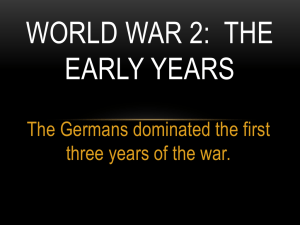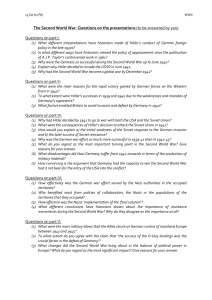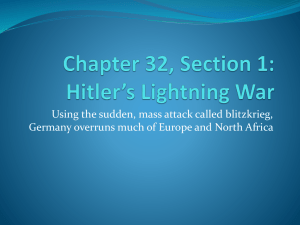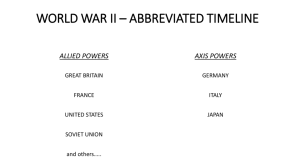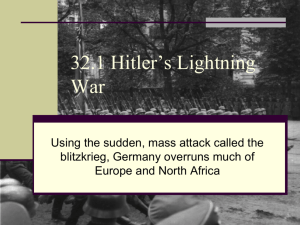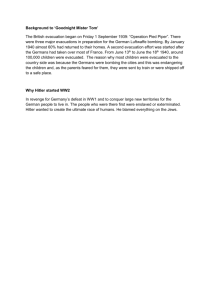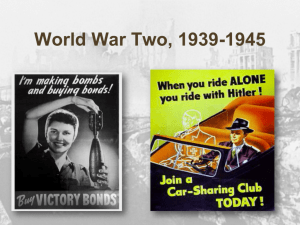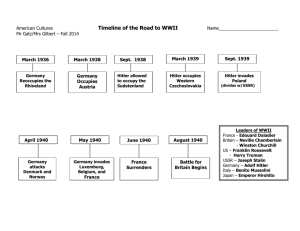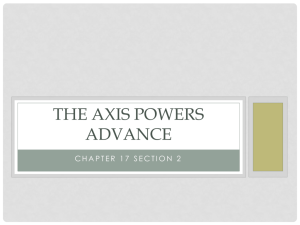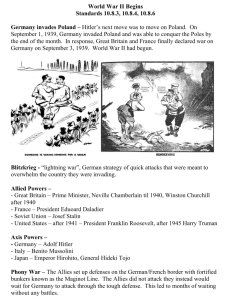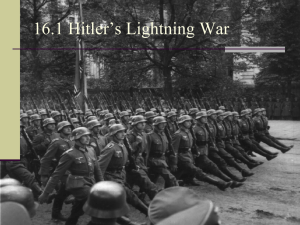Unit 3-2 Powerpoint
advertisement
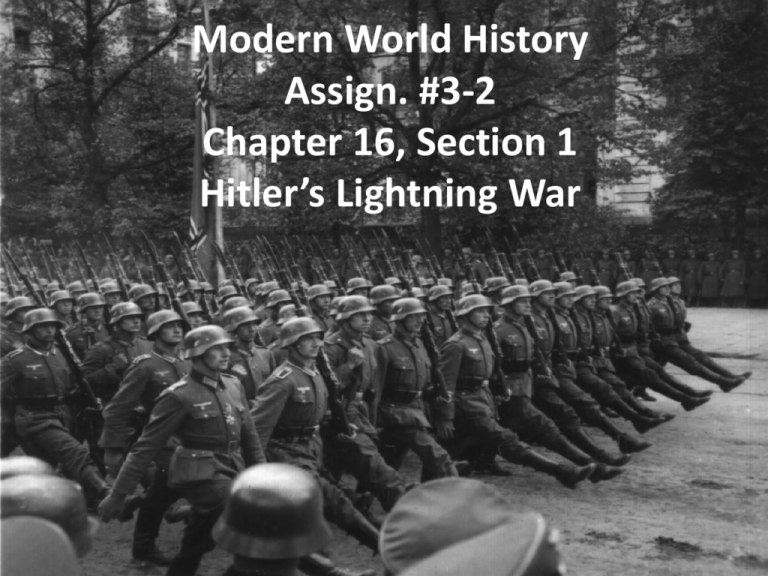
Modern World History Assign. #3-2 Chapter 16, Section 1 Hitler’s Lightning War Non-Aggression Pact (#1) • Nonaggression pact—Germans and Soviets agree not to fight each other. This was known as the “Molotov-Ribbentrop Pact” signed in 1939 • Stalin upset he was left out of the Munich Conference • Agreement includes secret deal to split Poland, and allows the USSR to take Finland and the Baltic States Ribbentrop and Stalin at the signing of the Pact Blitzkrieg on Poland (#2) • Germany’s Lightning Attack – September 1, 1939—Hitler launches invasion of Poland – Britain, France declare war on Germany, but Poland falls quickly – Blitzkrieg—lightning war— Germany’s new military strategy (play video to 5:25) – Planes and artillery bomb ahead of tanks, infantry trucks – used to surprise enemy and quickly conquer – How different than WWI? Territories Taken by Stalin (#3) “Winter War” • “Winter War” – Sept. 1939 to March 1940 • Finnish Resistance Heavy • 1 Million Soviet soldiers Invaded • Despite heavy losses, Soviets eventually force Finns to surrender after 6 months of fighting • “Molotov Cocktail” – invented by Finns and named after the Soviet Minister of Foreign Affairs “Sitzkrieg” • The Phony War – French, British mobilize along French border, wait for German attack – Many months of no action along western front—the “phony war” – The period of in action ends in April 1940 when Hitler unexpectedly attacks and quickly captures Denmark and Norway Denmark • Germany invades Denmark on April 9, 1940 • Denmark quickly surrenders to the Nazis, and cooperates with the German occupation. • However, King Christian X becomes a symbol of Danish resistance when he stays in his capital of Copenhagen and still goes on a daily horseback ride through the capital. • This picture taken in 1940 is of one of those rides. He is NOT accompanied by any armed guard. Norway • King Haakon of Norway (brother of Christian X of Denmark) refused to surrender to the Nazis, and was a symbol of Norwegian resistance. • He escaped to London and moved the Norwegian government in exile there. German infantry attacking through a burning Norwegian village. German Neubaufahrzeug tanks in Oslo. Western Front (#4) • Further Gains by Germans – May 1940—Germany conquers Netherlands, Belgium, Luxembourg – Meanwhile, another German force swings through the Ardennes Forest into France – Soon after, German army reaches French coast (10 minutes) – The German force was extended in a long thin line, with the Panzer tanks ahead, and the infantry trying to catch up – The Germans decided to wait for the infantry to catch up before turning toward the north to cut off British and French forces at Dunkirk Dunkirk Evacuation (#5) • Rescue at Dunkirk (5 min.) – German forces trap British, French on coast of Dunkirk – British Navy and civilians take ships across the English Channel to rescue soldiers British troops evacuating Dunkirk's beaches. Many stood shoulder deep in water for hours, waiting to board the warships. The Fall of France • France Falls – After the evacuation of Allied forces at Dunkirk, the Germans could turn south toward Paris without resistance – Paris was taken by June 14, 1940 – France surrenders to Germany on June 22, 1940 – France was defeated in less than 2 months (#6) France After Fall to Germany • After the surrender, the Germans took direct control of the northern portion of France • Vichy France – A puppet government was set up in the southern portion of France with the government located in the city of Vichy, France • Charles de Gaulle – a French general who set up a government-in-exile in London (known as the Free French government) that organized opposition to Germany, including a new French army that eventually returned to fight the Germans when France was liberated (#7) • Résistance – an underground group that fought against German occupation of France The Battle of Britain (#8) – Germany plans invasion of Britain; begins with air attacks in 1940 to knock out Royal Air Force (RAF) – Then Germany planned to invade with 250,000 soldiers – British use air force, radar, and code-breaking (with smuggled Enigma code machine) to resist Germany – Battle of Britain—Air war over Britain that lasted almost a year until May 1941 – Stunned by British resistance, Hitler calls off attacks A pair of British 264 Squadron Defiants Aircraft spotter on the roof of a building in London. St. Paul's Cathedral is in the background. Standing up gloriously out of the flames and smoke of surrounding buildings, St. Paul's Cathedral is pictured during the great fire raid of Sunday December 29, 1940. Over 500 firemen and members of the London Auxiliary Fire Fighting Services, including many women, combined in a war exercise over the ground covered by Greenwich (London) Fire Station." Ca. July 1939. Children of an eastern suburb of London, who have been made homeless by the random bombs of the Nazi night raiders, waiting outside the wreckage of what was their home." September 1940. Two bewildered old ladies stand amid the leveled ruins of the almshouse which was Home; until Jerry dropped his bombs. Total war knows no bounds. Almshouse bombed Feb. 10, Newbury, England“ in February 11, 1943. A London bus is submerged in a bomb crater after a German air raid. Later attempt to bomb Britain: View of a V-1 rocket (flying bomb) in flight, ca. 1944. The British nickname was a “Doodlebug” Winston Churchill’s Leadership (#9) • Winston Churchill— becomes British prime minister and vows no surrender • His broadcasted speeches rallied the people behind the effort to defeat Germany (2 min.) Winston Churchill giving his famous 'V' for victory sign After Battle of Britain (#10) • With a victory over Britain denied him Hitler weighs his options • What if he had stopped there? • Instead, he invades the following: – North Africa – The Balkans (Bulgaria, Romania, Hungary were persuaded to join the Axis Powers to avoid invasion, while Yugoslavia and Greece did not and were attacked) – Soviet Union Axis Forces Attack North Africa • Mussolini and Italy at first neutral • Mussolini declares war on France and Britain after German victory • September 1940— Mussolini attacks British in North Africa moving from their colony of Libya to Egypt On 13 September 1940 Italy launched the Tenth Army stationed in Libya in a 200,000 troop invasion into the British protectorate of Egypt and set up defensive forts at Sidi Barrani. But Italian Marshal Rodolfo Graziani, Governor-General of Libya, with little intelligence on the state of Allied forces there, chose not to continue further towards Cairo. Italian L3/33 in North Africa British Fight in North Africa (#11) • Britain Strikes Back – December 1940—British attack and drive Italians back – Erwin Rommel, German general, battles British in North Africa – In 1942, Rommel first retreats then succeeds against British at Tobruk, Libya – Germans begin push back into Egypt in June 1941 German General Erwin Rommel (“The Desert Fox”) with the 15th Panzer Division between Tobruk and Sidi Omar, Libya, January or November 24, 1941. British General Bernard L. Montgomery watches his tanks move up." North Africa, November 1942. War in the Balkans • Hitler plans to invade Soviet Union; moves to take Balkan countries first • Hitler invades Yugoslavia and Greece in April 1941; both fall quickly The Battle of Greece is generally regarded as a continuation of the Greco-Italian War, which began when Italian troops invaded Greece on October 28, 1940. Within weeks the Italians were driven out of Greece and Greek forces pushed on to occupy much of southern Albania. In March 1941, a major Italian counterattack failed, and Germany was forced to come to the aid of its ally. Operation Marita began on April 6, 1941, with German troops invading Greece through Bulgaria in an effort to secure its southern flank. The combined Greek and British Commonwealth forces fought back with great tenacity, but were vastly outnumbered and outgunned, and finally collapsed. Germany Invades Soviet Union • Hitler Invades the Soviet Union – Germany invades an unprepared Soviet Union in June 1941 – Hitler decides to split his forces into three groups • Germans stopped at Leningrad, forced to undertake long siege • Germans almost capture Moscow, but forced to pull back • A third army pushes into the southern region rich in oil Russian soldiers prepare to attack German lines outside Leningrad. A column of Red Army POWs captured near Minsk is marched west. A group of Soviet POWs, taken to undefined Prison Camp Russian Advantages (#12) • Though they are poorly equipped, the Soviet Union has the largest army in the world • scorched earth strategy – as Germans move into Russia, Soviet troops burn land as they retreat (taking advantage of the vast land) • As German invasion drags on and are bogged down outside of Leningrad and Moscow, it turns to winter
